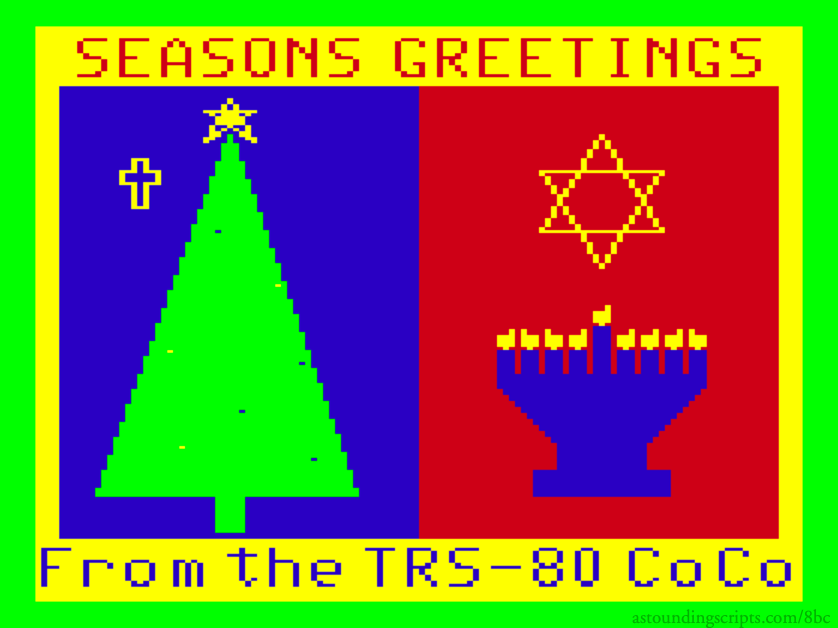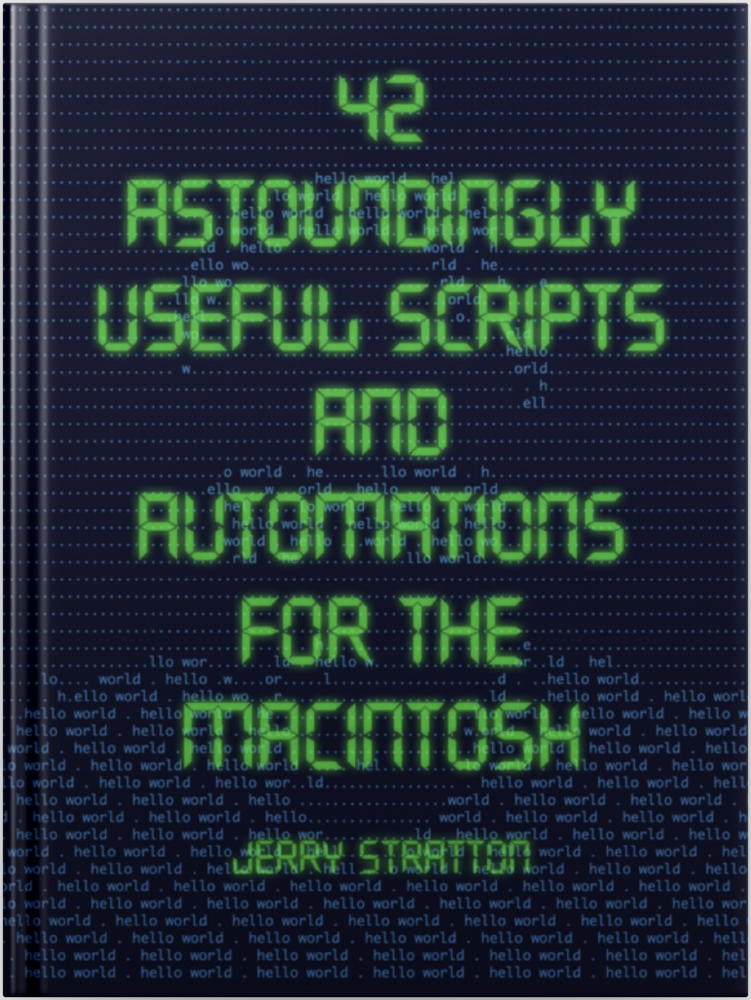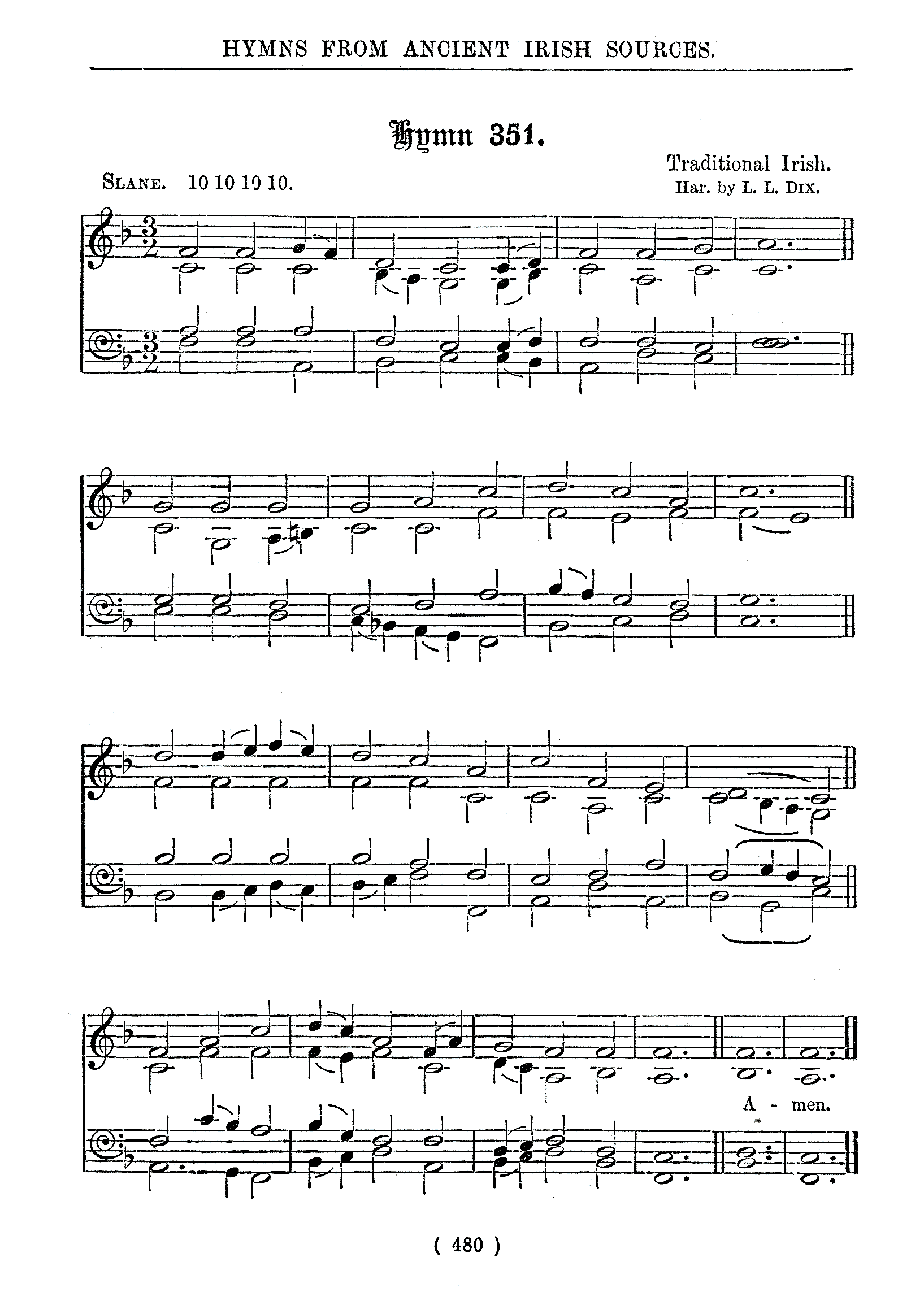The December issue of The Rainbow, a magazine for the TRS-80/Tandy Color Computer, always contained several Christmas programs, and many of those were Christmas art made on the very low color graphics of the era.
Here’s what the code tended to look like in the magazine:
[toggle code]
- 60 DIM A$(90)
- 70 A$(33)="U4E2F2D2NL4D2BR3" 'A
- 80 A$(34)="U6R3F1D1G1NL3F1D1G1L3BR7" 'B
- 90 A$(35)="BR3E1BU4H1L2G1D4F1R2BR4"'C
- 100 A$(36)="U6R3F1D4G1L3BR7" 'D
- 110 A$(37)="R4BU6L4D3NR2D3BR7" 'E
- 120 A$(38)="U6NR4D3NR2D3BR7" 'F
- 130 A$(39)="BR4BU5H1L2G1D4F1R3U2NL1D2BR3" 'G
- 140 A$(40)="U6D3R4U3D6BR3" 'H
- 150 A$(41)="BU6BR1R2L1D6L1R2BR4" 'I
- 160 A$(42)="BU1F1R2E1U5BD6BR3" 'J
- 170 A$(43)="U6D3R1NE3F3BR3" 'K
- 180 A$(44)="NU6R4BR3" 'L
- 190 A$(45)="U6F2ND1E2D6BR3" 'M
- 200 A$(46)="U6F4U4D6BR3" 'N
That’s from Joseph Kohn’s December 1984 code for “Season’s Greetings”. Each of those lines beginning with A$ after the line number is the code for drawing a letter. The Color Computer had a DRAW command that took one-letter directions such as U for up, E for heading up at a 45-degree angle, F for heading down at a 135-degree angle, D for down, and so on.
Line 70, the letter A, draws a line up 4 pixels, then goes right and up—at a 45-degree angle—for 2 pixels, down and right (a 135 degree angle) for 2 pixels, down for 2 pixels, goes left without updating the pen position (NL) for 4 pixels to draw the crossbar for the letter A, then completes the A’s right leg by drawing down for 2. Finally, it moves the pen right without drawing (BR) three pixels to prepare for the next letter.
If you have a Color Computer, or the emulator xroar, you can see it happening using this program:
- 10 REM DRAW LETTER A
- 20 DATA U4,E2,F2,D2,NL4,D2,BR3,END
- 30 PMODE 3,1
- 31 PCLS 2
- 32 SCREEN 1,0
- 40 READ D$
- 41 IF D$="END" THEN 100
- 42 DRAW D$
- 43 FOR I=1 TO 800:NEXT I
- 44 GOTO 40
- 100 GOTO 100
The DRAW command is how most of these images were made. By using an array of instructions, Kohn was able to put messages on the screen—and was able to let the person on the other end of the magazine, typing it in, change that message by changing which letters were drawn. This is the subroutine he used for that:
- 930 FORX1=1TO LEN(X$):Y1=ASC(MID$(X$,X1,1))-32:DRAW"XA$(Y1);":NEXT:RETURN
- Repeat for each position in the string to be displayed (X$).
- Get the ASCII code for the letter at the current position, reducing it by 32.
- Use that code as the position in the A$ array, and use the draw instructions at that position.
This could create some surprisingly beautiful imagery, even in the low resolution of the era. The Color Computer had only 256 by 192 pixels (that’s right, they weren’t even square pixels, they were rectangular), and that meant only two colors. Kohn created this image using PMODE 3; that was medium resolution, or only 128 by 192 pixels, but it gave him four colors to work with. One of the neat things about the Color Computer was that the instructions didn’t change when the resolution did—you always used high resolution commands, and the computer scaled it down for you if you told it to draw in medium or low resolution mode.

Tonight is the last night of Chanukah, so use your shammash to light all eight candles on the menorah.
I chose Kohn’s image first because it’s from 1984, which makes it among the earliest of the images I’ve chosen for these eight days. It also happens that this year, eight days before Christmas is also the eighth night of Chanukah, and Kohn’s image has the menorah candles lit as for the eighth night.
That’s it for day 111! Stay tuned for day 110.
In response to 8 (bit) Days of Christmas: Eight holiday images created on the TRS-80 Color Computer, from the early to mid eighties.
- TRS-80 Color Computer
- “The Radio Shack TRS-80 color computer (also called Tandy Color Computer, or CoCo) was a home computer based around the Motorola 6809E processor and part of the TRS-80 line.”
- XRoar—Dragon & CoCo emulator
- “XRoar is a Dragon emulator for Linux, Unix, Mac OS X and Windows. Due to hardware similarities, XRoar also emulates the Tandy Colour Computer (CoCo) models 1 & 2. More features.”
More Color Computer
- Simple game menu for the Color Computer 2 with CoCoSDC
- This simple menu provides one screen for cartridges saved in the CoCoSDC’s flash ROM, and any number of screens for your favorite games for your friends to play.
- Rainbow Magazine preflight tool enhanced
- I’ve added several features to the Rainbow Magazine preflight tool, including a check for references to line numbers that don’t exist.
- CoCoFest! 2021
- Forty years later, I finally make it to CoCoFest!
- BASIC tokenization examined
- Why do old BASIC programs have strange characters in their .BAS files? Why do they look like they’re compiled code?
- What are the 8 bits in 8-bit computing?
- Retro computing is often called 8-bit computing. This is because the bytes that these computers use are composed of eight bits, and much of what the computer does is operating on these individual bits, not on the byte as a whole.
- 19 more pages with the topic Color Computer, and other related pages
More computer history
- Creative Computing and BASIC Computer Games in public domain
- David Ahl, editor of Creative Computing and of various BASIC Computer Games books, has released these works into the public domain.
- Hobby Computer Handbook: From 1979 to 1981
- Hobby Computer Handbook lived for four issues, from 1979 to 1981. Back in 1979 and 1980, I bought the middle two issues. I’ve recently had the opportunity to buy and read the bookend issues.
- Hobby Computer Handbook
- Hobby Computer Handbook was a short-lived relic of the early home computer era, an annual (or so) publication of Elementary Electronics.
- 8 (bit) Days of Christmas: Day 11 (O Christmas Tree)
- Day 11 of the 8 (bit) days of Christmas is the graphic accompaniment to “O Tannenbaum” from Robert T. Rogers “Holly Jolly Holidays”, from December 1984.
- 8 (bit) Days of Christmas: Day 100 (Hearth)
- Lower resolution graphics were more appropriate for animation, because you could page through up to eight screens like a flip book. This is Eugene Vasconi’s Holiday Hearth from December 1986.
- Six more pages with the topic computer history, and other related pages
More The Rainbow magazine
- Rainbow Magazine preflight tool enhanced
- I’ve added several features to the Rainbow Magazine preflight tool, including a check for references to line numbers that don’t exist.
- 8 (bit) Days of Christmas: Day 1 (Do You Hear What I Hear?)
- For day 1 of the 8 (bit) days of Christmas, John Mosley’s “Do You Hear What I Hear?” from the December, 1987, Rainbow Magazine. Mosley coaxes four-voice music out of the CoCo 1 and 2 using a machine-language program.
- 8 (bit) Days of Christmas: Day 10 (Up on the Rooftop)
- In the December 1986 Rainbow, J. D. German presented us with this game, involving flying and landing Santa to deliver presents!
- 8 (bit) Days of Christmas: Day 11 (O Christmas Tree)
- Day 11 of the 8 (bit) days of Christmas is the graphic accompaniment to “O Tannenbaum” from Robert T. Rogers “Holly Jolly Holidays”, from December 1984.
- 8 (bit) Days of Christmas: Day 100 (Hearth)
- Lower resolution graphics were more appropriate for animation, because you could page through up to eight screens like a flip book. This is Eugene Vasconi’s Holiday Hearth from December 1986.
- Five more pages with the topic The Rainbow magazine, and other related pages

